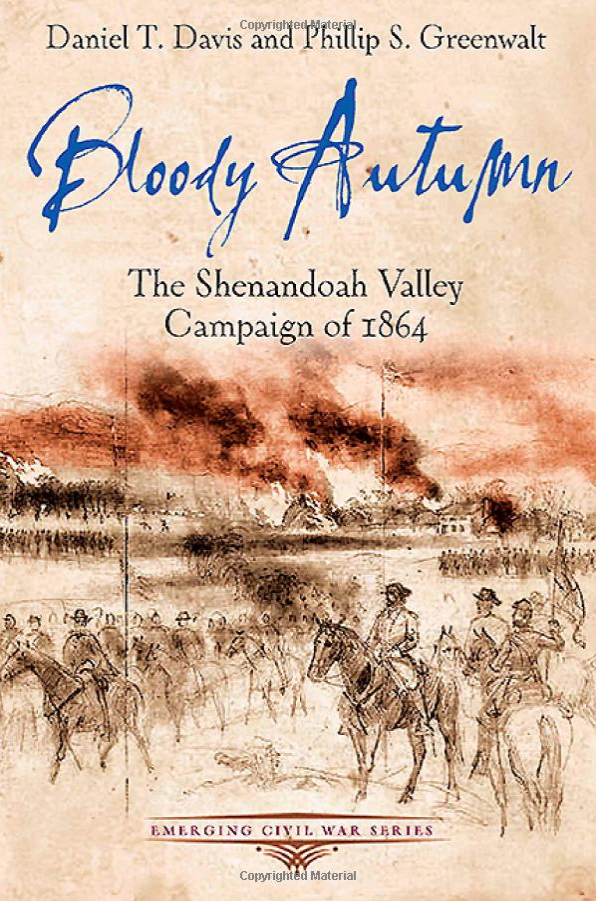Bloody Autumn: The Shenandoah Valley Campaign of 1864 by Daniel T. Davis and Phillip S. Greenwalt. Savas Beatie, 2014. Cloth, ISBN: 1611211654. $12.95.
 Although historians still need to reserve judgment on the effectiveness of sesquicentennial commemorations, one thing is certain as the Civil War’s 150th anniversary enters its fourth spring — the sesquicentennial has produced a robust outpouring of books on a wide array of topics. While numerous publishers have released groundbreaking studies, some publishers, most notably The History Press and Savas Beatie, have viewed the sesquicentennial as an opportunity to release a series of condensed studies about the conflict’s most significant battles and campaigns for general audiences. This recent title in Savas Beatie’s Emerging Civil War Series authored by Daniel T. Davis and Phillip S. Greenwalt continues that mission of offering succinct and accessible studies.
Although historians still need to reserve judgment on the effectiveness of sesquicentennial commemorations, one thing is certain as the Civil War’s 150th anniversary enters its fourth spring — the sesquicentennial has produced a robust outpouring of books on a wide array of topics. While numerous publishers have released groundbreaking studies, some publishers, most notably The History Press and Savas Beatie, have viewed the sesquicentennial as an opportunity to release a series of condensed studies about the conflict’s most significant battles and campaigns for general audiences. This recent title in Savas Beatie’s Emerging Civil War Series authored by Daniel T. Davis and Phillip S. Greenwalt continues that mission of offering succinct and accessible studies.
Davis and Greenwalt, both with National Park Service backgrounds, do not aim to break new ground with this brief volume, but instead offer it as a resource to acquaint individuals unfamiliar with the maneuvers, battles, personalities, and consequences of Gen. Philip H. Sheridan’s 1864 Shenandoah Campaign.
Throughout the prolifically illustrated book, Davis and Greenwalt do an admirable job explaining the movements and outcomes of the Third Battle of Winchester, Fisher’s Hill, Tom’s Brook, and Cedar Creek. Additionally, the authors present a brief but effective glimpse of that most destructive period of Sheridan’s 1864 Shenandoah Campaign — “The Burning.”
The book’s second part consists of a series of driving tours examining each of the campaign’s actions. While the tours ably navigate those unfamiliar with the campaign to key locations, the authors might have considered adding a few key stops to some of their tours. For example, the Third Winchester tour would have been improved by including Sheridan’s Field Hospital site, and the Cedar Creek tour would have been further enhanced by including stops such as St. Thomas Episcopal Church in Middletown. Along with many other buildings in the community, it served as a field hospital after the battle.
In the book’s third part, the authors include four appendices and an order of battle. The first two appendices offer a brief glimpse of Civil War Winchester and the Union executions at Front Royal in late September 1864. The third appendix, authored by Greenwalt and Chris Mackowski, offers a brief examination of the campaign in memory. It focuses especially on Sheridan’s ride — first immortalized in poetry by Thomas Buchanan Read. The fourth appendix, authored by Cedar Creek and Belle Grove National Historical Park historian Eric Campbell, offers a cogent examination of the ongoing battlefield preservation movement in the Shenandoah Valley.
Despite the book’s many fine attributes as a short introduction to Sheridan’s 1864 Shenandoah Campaign, the book does lack in a few areas – most notably how the campaign impacted the lives of the Shenandoah Valley’s civilians. Each of the campaign’s battles that autumn did not occur in some far off hinterland, but rather on people’s farms, in families’ backyards, and in the streets of the Shenandoah Valley’s communities. Aside from brief discussions of “The Burning” in chapter seven and a brief nod in the appendix on Winchester, the authors do not do an adequate job of integrating the interactions between military operations and civilian populations in the region—an element essential to any study of this campaign. Esteemed Civil War historian George Rable stated years ago that the only way to have a complete understanding of any campaign or battle is to fully explain the interplay between the military and civilian elements. Historian Gary W. Gallagher reiterated Rable’s sound advice at the Virginia State Civil War Sesquicentennial Signature Conference, “Leadership and Generalship in the Civil War,” held at the Virginia Military Institute in 2012.
The 1864 Shenandoah Campaign not only impacted the Shenandoah Valley’s population, but forced some civilians to play integral roles — ones which helped to shape the course of the campaign. Glaringly absent from the narrative on the Third Battle of Winchester is a discussion of Rebecca Wright—a woman whom Sheridan’ believed was “worth a whole brigade.” Wright offered Sheridan vital information about the departure of Confederate troops from the Shenandoah Valley, which ultimately led Sheridan to strike Winchester. While that departure of troops is discussed, Davis and Greenwalt do not even acknowledge Wright’s role in sending that information through Tom Laws, an African American man from Millwood, Virginia, to Sheridan. The authors merely state that when Sheridan learned of the departure of Gen. Joseph Kershaw’s division and Maj. Wilfred Cutshaw’s artillery battalion from the Shenandoah Valley, “Sheridan’s mindset began to change.” It is somewhat egregious that the authors ignore the woman who provided the information that shaped Sheridan’s thinking and consequently the campaign. Certainly the woman Sheridan regarded as “one of the genuine heroines of the war” deserved at least a mention.
Another part of the book which could have used more attention is the suggested reading section. While the four books listed are solid studies, a list of four volumes on a topic which has produced dozens of useful titles seems rather anemic.
While this book does have its shortcomings and will appeal little to those familiar with the campaign’s complex dimensions, Davis and Greenwalt’s study nonetheless serves as a nice introduction for those completely unfamiliar with Sheridan’s 1864 Shenandoah Campaign — a campaign which finally wrested the Shenandoah Valley from a once firm Confederate grip, aided President Abraham Lincoln in his bid for reelection in November 1864, and added to the pressure which ultimately forced the Confederacy’s surrender.
Jonathan A. Noyalas is Assistant Professor of History and Director of the Center for Civil War History at Lord Fairfax Community College in Middletown, Virginia. He is the author or editor of nine books, including The Battle of Fisher’s Hill: Breaking the Valley’s Gibraltar (2013).
